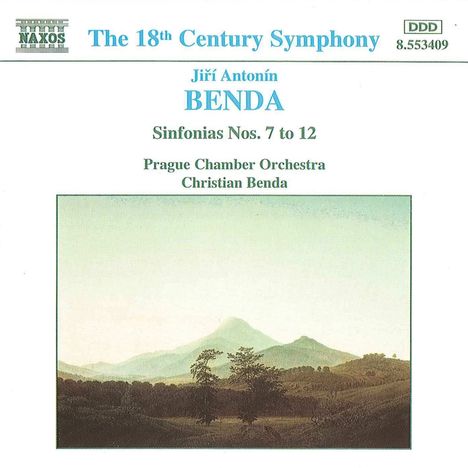Georg Anton Benda: Symphonien Nr.7-12 auf CD
Symphonien Nr.7-12
Herkömmliche CD, die mit allen CD-Playern und Computerlaufwerken, aber auch mit den meisten SACD- oder Multiplayern abspielbar ist.
(soweit verfügbar beim Lieferanten)
- Künstler:
- Prague Chamber Orchestra, Christian Benda
- Label:
- Naxos
- Aufnahmejahr ca.:
- 1995
- Artikelnummer:
- 7542151
- UPC/EAN:
- 0730099440929
- Erscheinungstermin:
- 14.9.1995
- Serie:
- Naxos 18th Century Classics
Die Sinfonia Nr. 7 in D-Dur beginnt mit einem lebhaften Allegro assai, gefolgt von einem Moll-Larghetto mit zwei Flöten, die einen Klangkontrast bilden. Die Sinfonia endet mit einem abschließenden Presto, das die sanfte Stimmung des vorhergehenden Satzes unterbricht, aber seine eigenen deutlichen Kontraste mitbringt. Die Sinfonia Nr. 8 in D-Dur beginnt mit einem Crescendo, das Mannheim ebenbürtig ist. Es gibt einen langsamen Satz in bewegter Moll-Tonart und ein zügiges Spirituoso zum Finale. Die Sinfonia Nr. 9 in A-Dur beginnt kühn mit einer Textur, in der die Hörner Bedeutung erlangen. Das folgende Moll-Andante, eine Oboenarie, führt zu einem kräftig fröhlichen Finalsatz. Die Sinfonia Nr. 10 in G-Dur beginnt mit dem üblichen Appell an die Aufmerksamkeit des Zuhörers und macht dann spielerisch Gebrauch von einer wiederkehrenden Oktavfigur, mit einer aktiven Rolle für Fagott und andere Blasinstrumente, die in dem Satz, der auf das sehr kurze Andante folgt, eine herausragende Stellung einnehmen. Die Sinfonia Nr. 11 in F-Dur geht nach einem ersten Satz, der sein eigenes Licht und seinen eigenen Schatten hat, in ein zentrales Larghetto über, das wiederum in seiner Molltonart lyrisch ergreifend ist. Die Sinfonia endet mit dem zu erwartenden Allegro im Dreiertakt. Die Sinfonia Nr. 12 in A-Dur beginnt mit einem Allegro, das kurze Momente des Kontrasts im Modus bietet. Der zweite Satz ist markiert, mit einem momentanen Rückfall ins Lateinische, da Andantino semper piano ohne Pause folgt. Hier hat die Flöte eine Hauptrolle zu spielen; sie wird kurz von den Hörnern unterbrochen, bevor der Satz zu Ende geht. Die Sinfonia endet mit einem Allegro in einem Werk, von dem man einst behauptete, dass es zusammen mit Bendas anderen Sinfonien in der zeitgenössischen Popularität mit denen von Haydn und Mozart konkurriert habe.
Product Information
The Sinfonia No. 7 in D major starts with a lively Allegro assai, followed by a minor key Larghetto with two flutes providing a contrast of timbre. The sinfonia ends with a final Presto, interrupting the gentle mood of the preceding movement, but bringing its own distinct contrasts. Sinfonia No. 8 in D major starts with a crescendo worthy of Mannheim. There is a moving minor key slow movement and a brisk final Spirituoso. Sinfonia No. 9 in A major opens boldly with a texture in which the horns assume importance. The following minor key Andante, an oboe aria, leads to a robustly cheerful final movement. Sinfonia No. 10 in G major starts with the customary call on the listener’s attention and goes on to make playful use of a recurrent octave figure, with an active rôle for bassoon and other wind instruments, which have a prominent place in the movement that follows the very brief Andante. Sinfonia No. 11 in F major, after a first movement that has its own light and shade, moves forward to a central Larghetto, again lyrically poignant in its minor key. The sinfonia ends with expected triple metre Allegro. Sinfonia No. 12 in A major opens with an Allegro that provides brief moments of contrast in mode. The second movement is marked, with a momentary lapse into Latin, as Andantino semper piano, follows without a break. Here the flute has a leading part to play; briefly interrupted by the horns before the movement comes to an end. The sinfonia finishes with an Allegro in a work that, together with Benda’s other symphonies, was once claimed to have rivalled those of Haydn and Mozart in contemporary popularity.
Disk 1 von 1 (CD)
-
1 Sinfonia No. 7 in D major: I. Allegro assai
-
2 Sinfonia No. 7 in D major: II. Larghetto
-
3 Sinfonia No. 7 In D Major: Iii. Presto
-
4 Sinfonia No. 8 in D major: I. Allegro
-
5 Sinfonia No. 8 in D major: II. Andante
-
6 Sinfonia No. 8 In D Major: Iii. Spirituoso
-
7 Sinfonia No. 9 in A major: I. Allegro
-
8 Sinfonia No. 9 in A major: II. Arioso con sordini
-
9 Sinfonia No. 9 In A Major: Iii. Allegro
-
10 Sinfonia No. 10 in G major: I. Allegro scherzando
-
11 Sinfonia No. 10 in G major: II. Andante
-
12 Sinfonia No. 10 In G Major: Iii. Allegro Ma Moderato
-
13 Sinfonia No. 11 in F major: I. Allegro
-
14 Sinfonia No. 11 in F major: II. Larghetto
-
15 Sinfonia No. 11 In F Major: Iii. Allegro
-
16 Sinfonia No. 12 in A major: I. Allegro
-
17 Sinfonia No. 12 in A major: II. Andantino sempre piano
-
18 Sinfonia No. 12 In A Major: Iii. Allegro
Mehr von Georg Anton Benda
-
Georg Anton BendaCembalokonzerte in f, F, G & hSuper Audio CDAktueller Preis: EUR 7,99
-
The Age of Extremes - WF Bach / CPE Bach / BendaCDAktueller Preis: EUR 19,99
-
Weimar 1755 - Johann Ernst Bach & Georg Anton BendaCDVorheriger Preis EUR 19,99, reduziert um 0%Aktueller Preis: EUR 14,99
-
Georg Anton BendaCembalosonaten Nr.1-6 (1757)CDAktueller Preis: EUR 19,99






